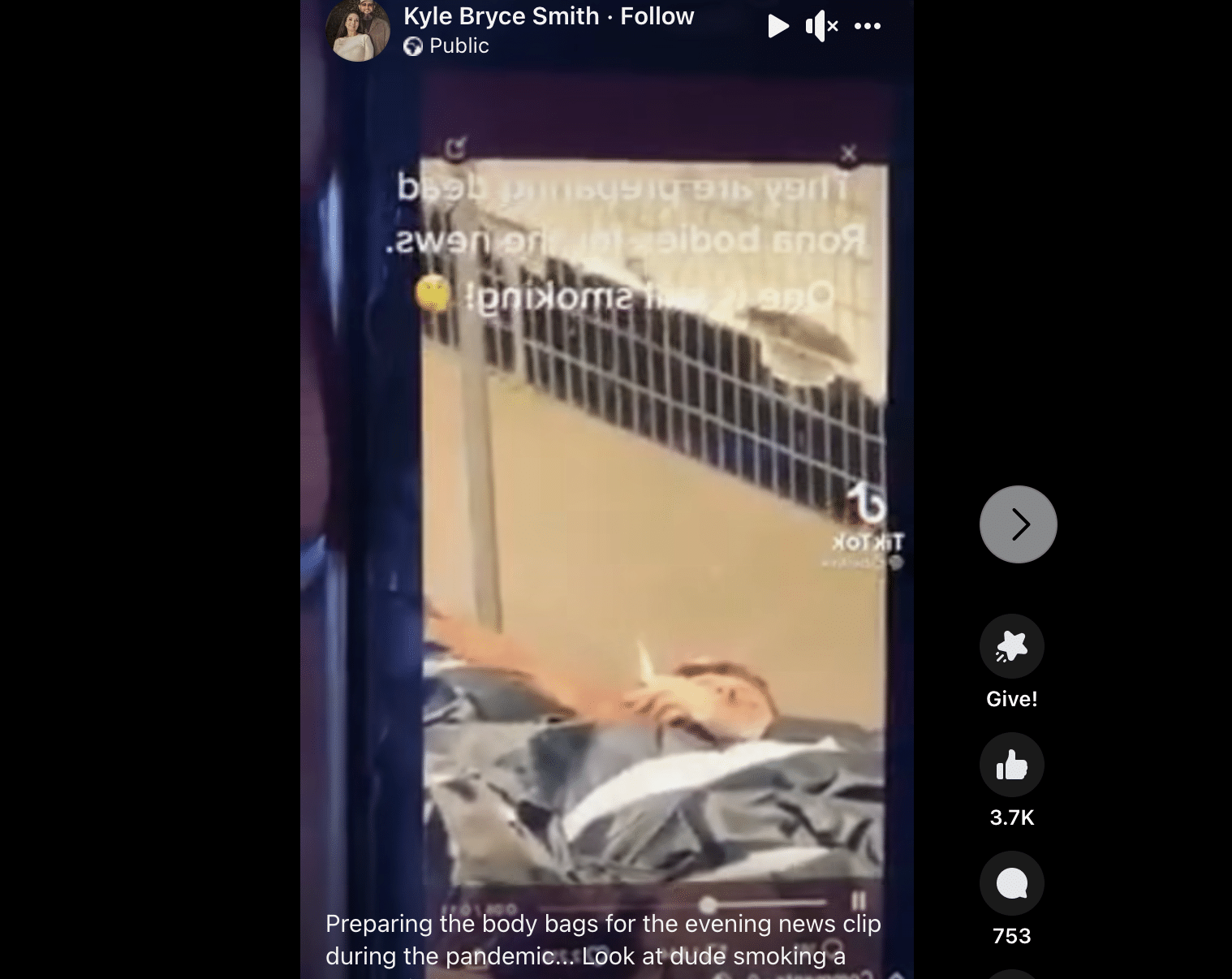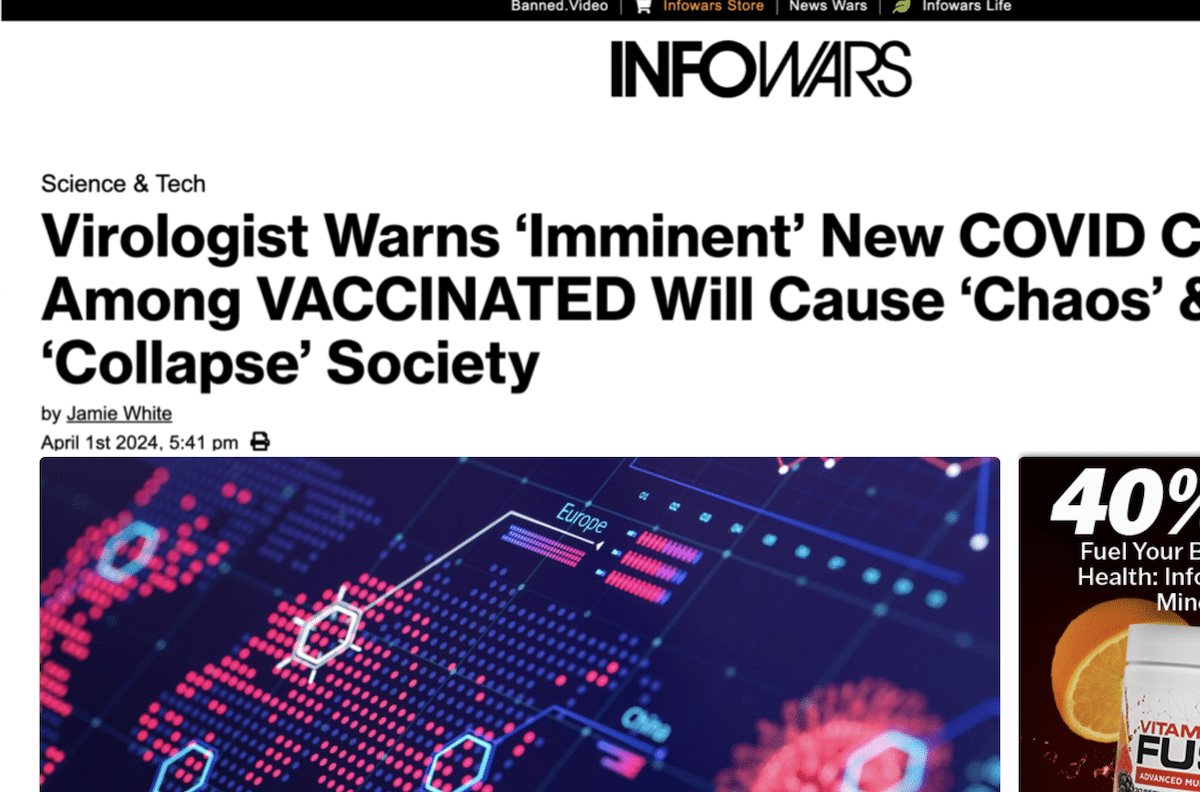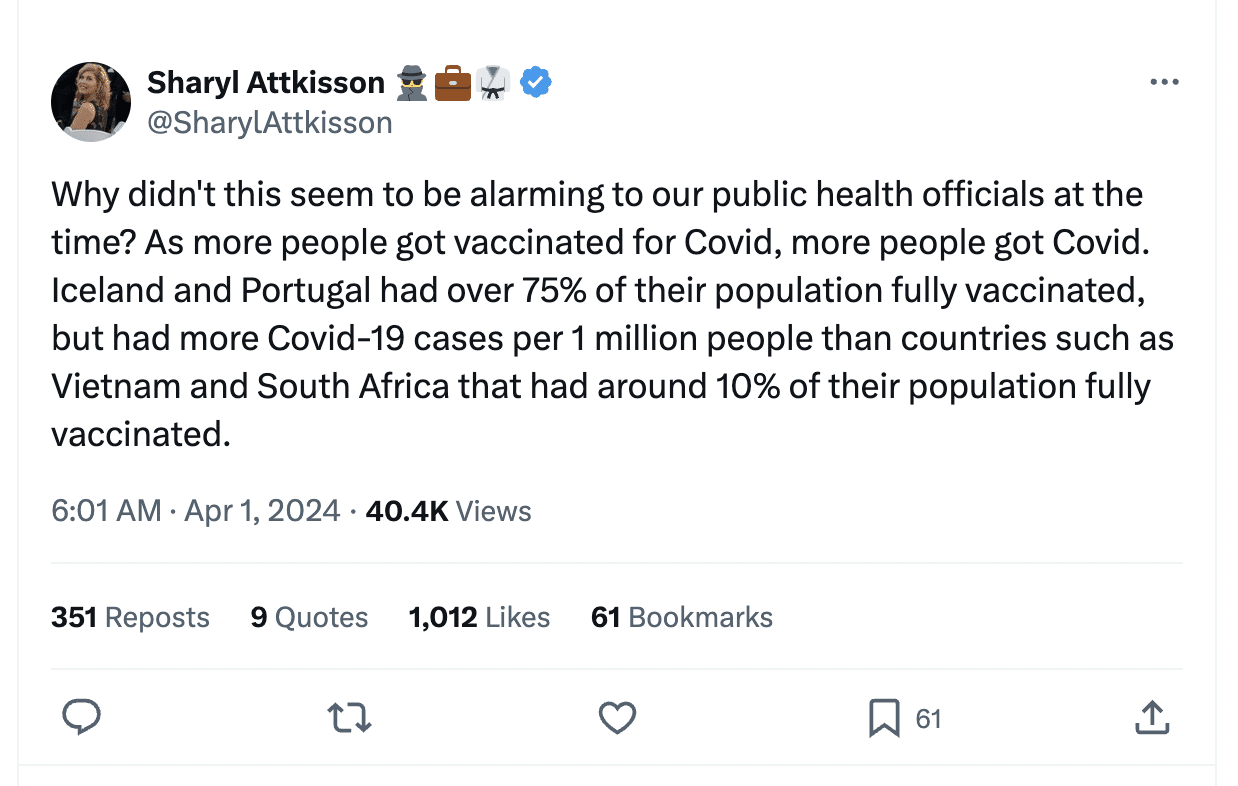- Health
Mask-wearing helps to reduce the spread of COVID-19; social media posts misinterpreted Annals of Internal Medicine study on N95 respirators
Key takeaway
Although mask-wearing doesn’t prevent people from catching COVID-19 with 100% effectiveness, multiple peer-reviewed studies have shown that mask-wearing can and does meaningfully reduce the risk of transmitting the virus. Furthermore, mask-wearing isn’t associated with serious long-term health problems, whereas COVID-19 is. Consequently, mask-wearing is a low-risk intervention that offers important public health benefits, particularly during a pandemic caused by a respiratory virus.
Reviewed content
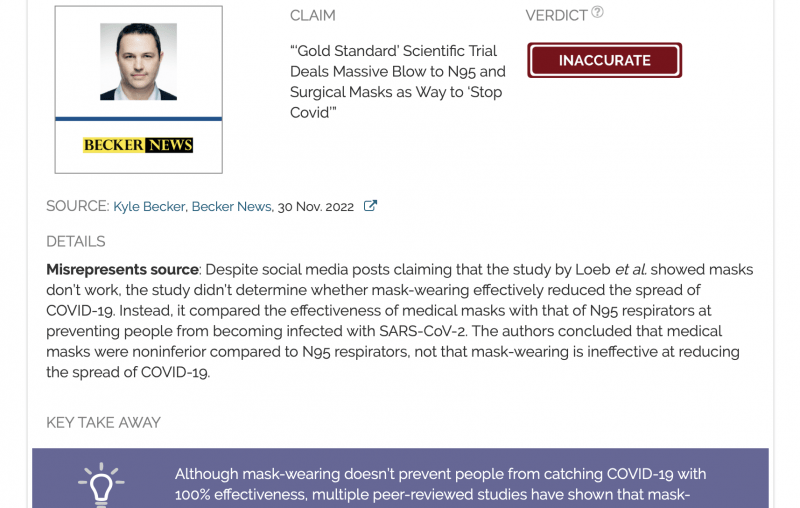
Verdict:
Claim:
“‘Gold Standard’ Scientific Trial Deals Massive Blow to N95 and Surgical Masks as Way to ‘Stop Covid’”
Verdict detail
Misrepresents source: Despite social media posts claiming that the study by Loeb et al. showed masks don’t work, the study didn’t determine whether mask-wearing effectively reduced the spread of COVID-19. Instead, it compared the effectiveness of medical masks with that of N95 respirators at preventing people from becoming infected with SARS-CoV-2. The authors concluded that medical masks were noninferior compared to N95 respirators, not that mask-wearing is ineffective at reducing the spread of COVID-19. Factually inaccurate: Contrary to the article, SeroHub data didn’t show that 97% of the American public had been infected by SARS-CoV-2 as of July 2022. This figure represented only the seroprevalence in children in Utah and is therefore not generalizable to the U.S. population.
Full Claim
‘A Randomized Control Trial (RCT), the gold standard for scientific evidence in the medical community, was released on Tuesday in the Annals of Internal Medicine. The results from the RCT study deal a major blow to advocates of N95 and surgical masks as effective means to “stop Covid.”’; a Danish study “showed that there was no statistically significant difference in Covid risk between wearing a mask and not wearing a mask”; “Serohub shows that as of July 2022, 97% of the American public had been exposed to the SARS-CoV-2 virus”
Review
A study in the peer-reviewed journal Annals of Internal Medicine, published at the end of November 2022, generated renewed discussion over the effectiveness of mask-wearing against COVID-19[1]. According to the social media analytics tool Buzzsumo, the study received more than 4,500 user engagements on Facebook, Twitter, and Reddit.
The study examined 1,009 healthcare workers from 29 healthcare facilities in Canada, Israel, Pakistan, and Egypt between May 2020 and March 2022. Participants were randomized to two groups: medical masks (also called surgical masks) or N95 respirators, with the aim of determining which mask performed better at preventing people from catching COVID-19. Between the two, N95 respirators are considered to provide more protection, given that they fit more closely to the face compared to medical masks.
The researchers reported that PCR-confirmed COVID-19 cases occurred in roughly 10% of participants in the medical mask group, which was quite similar to the cases in the N95 respirator group (about 9%). This led the researchers to conclude that medical masks were noninferior to N95 respirators.
However, many social media users interpreted the study to mean that mask-wearing is ineffective at reducing the spread of COVID-19, like this tweet by art dealer Eli Klein that proclaimed “Masks hardly work, if at all”. One article published by the website Becker News, which was also shared on social media, ran in the same vein, claiming that “‘Gold Standard’ Scientific Trial Deals Massive Blow to N95 and Surgical Masks as Way to ‘Stop Covid’”. That article received more than 12,000 interactions on Twitter, thanks to Kyle Becker’s tweet.
Mark Loeb, the first author of the study and chair of infectious diseases at McMaster University, told Health Feedback in an email that such an interpretation was inaccurate.
While the study did report that N95 respirators didn’t significantly outperform medical masks in terms of preventing COVID-19 cases, the study didn’t include a group that didn’t wear masks. As such, “comments about the absolute effect of the mask or N95 respirator to protect against COVID-19 cannot be made on the basis of our trial,” Loeb cautioned.
He explained the results thus: “There was a 1.19% increase in the risk of COVID-19 infection in participants that were assigned to medical masks compared to N95 respirators. This is known as the point estimate and is the result that is closest to the true effect. The confidence intervals around this, that is, what the possible results could be if the trial was repeated many times, range from -2.5% to 4.9%. This means that the risk of a COVID-19 infection in those using the medical masks could have ranged from anywhere from 2.5% reduction in risk to a 4.9% increase in risk”.
In the study, the authors acknowledged several limitations. For example, the study participants could have been infected by SARS-CoV-2 outside of the healthcare setting, when they weren’t wearing masks. Given that an intervention can only work when it’s being applied, the number of COVID-19 cases in both groups may not necessarily be related to the effectiveness of the type of face masks.
Other experts, who weren’t involved in the study, also discussed a few other caveats in an article by the Center for Infectious Disease Research and Policy at the University of Minnesota, warning that the results should be interpreted with caution. One of these caveats is that healthcare workers could use N95 respirators if they believed at any time that this was necessary, even if they had been randomized to the medical mask group. Such a mixture of multiple interventions makes it difficult to attribute the observed effect to a specific intervention. [Editor’s note: The company 3M, which manufactures N95 respirators among other things, provides partial financial support to the Center. One of the scientists quoted in the article, Raina McIntyre, received research funding from 3M more than ten years ago, per a declaration in a 2020 study.]
In response to this criticism of the study, Loeb told Health Feedback that participants’ adherence to their assigned mask or respirator group “in monitored audits of compliance was more than 95%, which is not mentioned in the CIDRAP article”. According to the study, these audits were performed by observing staff during a randomly selected 20% of shifts at healthcare facilities. One limitation is that “Wearing an N95 respirator for aerosol-generating procedures was not considered during the observed audits”, as noted in the study.
The Becker News article also cited “a famous Danish study” that allegedly found “no statistically significant difference in Covid risk between wearing a mask and not wearing a mask”. However, this isn’t what the study was designed to determine, as a previous Health Feedback review reported. Instead, the Danish study was designed to determine whether recommending that people wear face masks reduces their risk of COVID-19 infection by 50%[2]. Indeed, an editorial by the Annals of Internal Medicine, which published the study, also clarified this point. In addition, the authors stated that their findings were “inconclusive”.
Furthermore, the Danish study only evaluated the ability of face masks to protect the wearer. Hence, the study does not address whether wearing face masks are effective at reducing the spread of COVID-19 from an infected to uninfected person (source control). This is the basis of the recommendation for even healthy people to wear masks, since infected people don’t always show symptoms.
The first author of the Danish study, Henning Bundgaard, told Forbes that “Even a small degree of protection is worth using the face masks”.
Apart from misrepresenting these studies, the Becker News article also inaccurately interpreted data from the COVID-19 SeroHub, a joint project between the U.S. Centers for Disease Control and Prevention, the National Cancer Institute (NCI), and the National Institute of Allergy and Infectious Diseases.
The article claimed that “as of July 2022, 97% of the American public had been exposed to the SARS-CoV-2 virus”. Based on this claim, it implied that measures to reduce the spread of COVID-19 were useless, alleging “it did not matter whether one wore a mask or did not wear a mask, […] was vaccinated or not vaccinated, […] socially distanced or did not socially distance, […] in a lockdown or wasn’t in a lockdown, virtually everyone was exposed to the coronavirus during the pandemic”.
In an email to Health Feedback, Neal Freedman, a senior investigator at the NCI’s Division of Cancer Epidemiology and Genetics, refuted these claims.
“The 97% figure is not the national estimate but the datapoint for the state of Utah alone. The nationwide exposure estimate in July 2022 was 86.3%,” said Freedman. He also clarified that the 97% figure was derived from a pediatric population, therefore adults weren’t included.
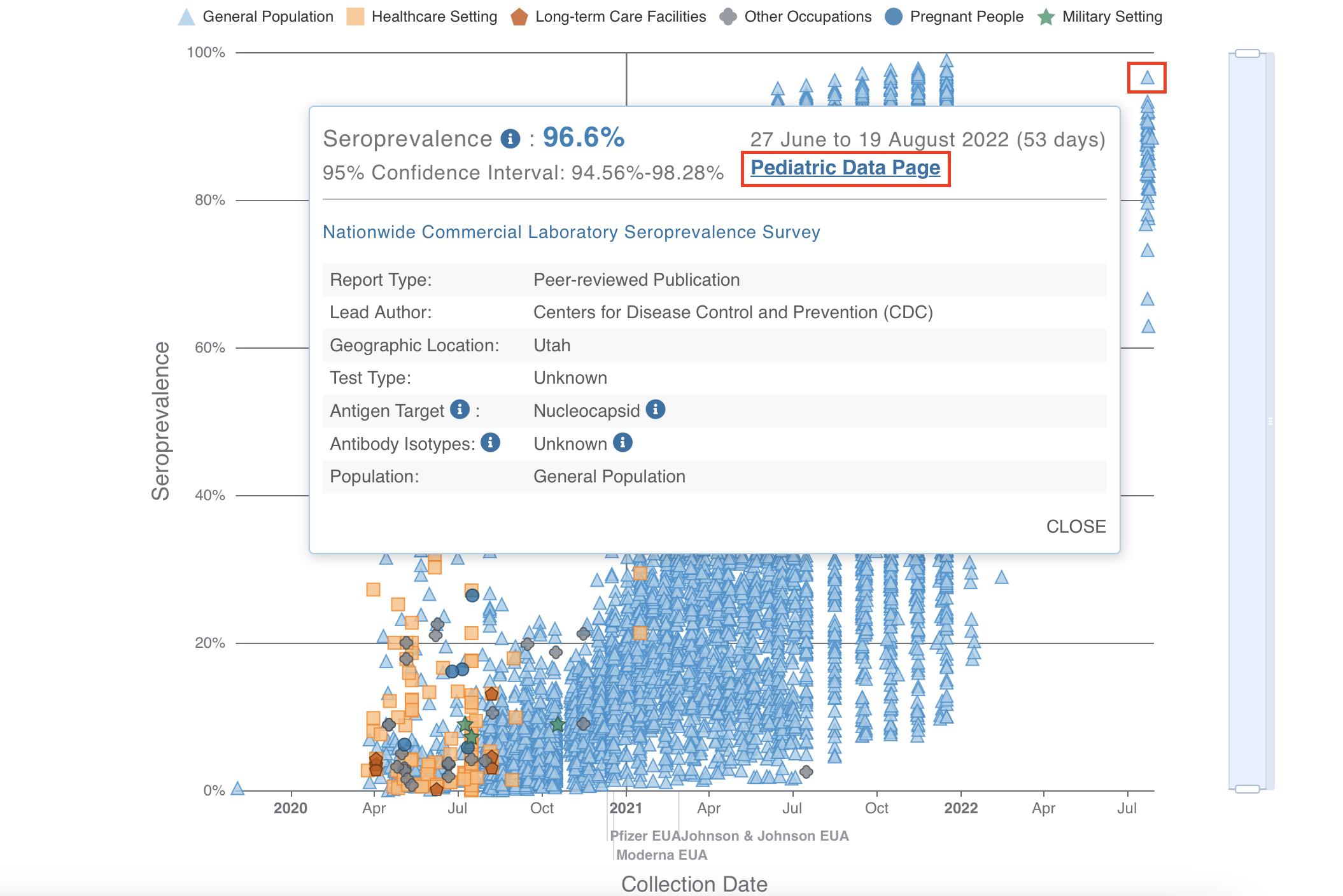
Figure 1. Screenshot of SeroHub graph displaying seroprevalence reported by various studies. The blue triangle in a red box marks the reference point used in the Becker News article that alleged a national seroprevalence of 97% in July 2022. Clicking on the blue triangle brings up a pop-up box with additional information about the origins of the seroprevalence data. As the pop-up box shows, the 97% figure came from a pediatric population. Data retrieved from SeroHub on 13 December 2022.
In addition, the exposure estimate varied greatly depending on geography, ranging from 62.9% in Puerto Rico to 96.6% in Utah.
Freedman cautioned that SeroHub data couldn’t be used to draw conclusions about the effectiveness of COVID-19 measures, as it “does not track extremely important metrics such as the number of people who got very sick and died from SARS-CoV-2”.
Health Feedback attempted to reach out to Becker for comment via the email address provided on the Becker News website, but was unsuccessful.
Findings from multiple peer-reviewed studies support community mask-wearing as a useful measure to reduce the spread of COVID-19. Loeb cited a study performed in Bangladesh, which he considered to provide “among the best estimates for absolute effect for surgical masks in the community”[3]. The study reported that the group receiving multiple mask-promoting interventions, including the distribution of free masks, had a reduction of about 10% in the number of people who became infected, when compared to the control group that received no interventions.
A study in Johnson County, Iowa, reported that when an uninfected person and infected person both wore a face mask, the secondary attack rate—the rate at which the infected person passes on the infection to the initially uninfected person—was halved from from 25.6% to 12.5%[4]. A similar benefit was also reported in a study of Beijing households, which found a 79% effectiveness in reducing transmission between an infected person and family members living in the same household, when both parties wore masks[5].
In an article for JAMA Network, scientists from the U.S. Center for Disease Control and Prevention explained that the benefit of mask-wearing to individuals grows with the number of people that choose to wear masks:
“The overall community benefit of wearing masks derives from their combined ability to limit both exhalation and inhalation of infectious virus. Similar to the principle of herd immunity for vaccination, the greater the extent to which the intervention—mask wearing in this case—is adopted by the community, the larger the benefit to each individual member.”
In summary, the study by Loeb et al. was designed to compare the effectiveness of medical masks with that of N95 respirators to determine which one was better at protecting people from becoming infected with SARS-CoV-2. It didn’t compare mask-wearing groups with a non-mask-wearing group, therefore the study doesn’t provide evidence that mask-wearing doesn’t work to reduce the spread of COVID-19, contrary to popular interpretations offered by social media users. While mask-wearing cannot prevent COVID-19 with 100% effectiveness, studies show that it can and does meaningfully reduce the risk of virus transmission.
UPDATE (13 December 2022):
This review was updated to include a comment by NCI senior investigator Neal Freedman regarding the claims about SeroHub data made in the Becker News article. The comment was inserted after the thirteenth paragraph. A screenshot was also included to illustrate the comment; an additional Detail was also added to reflect this new information. This comment further supports our original verdict and did not change it.
UPDATE (8 December 2022):
This review was updated to indicate that the Center for Infectious Disease Research and Policy at the University of Minnesota is financially supported in part by the company 3M, which manufactures N95 respirators. We also added a new paragraph after the ninth paragraph, stating Loeb’s response to criticism about the study published by the Center and providing an explanation of how audits of compliance were performed according to the study.
REFERENCES
- 1 – Loeb et al. (2022) Medical Masks Versus N95 Respirators for Preventing COVID-19 Among Health Care Workers: A Randomized Trial. Annals of Internal Medicine.
- 2 – Bundgaard et al. (2021) Effectiveness of Adding a Mask Recommendation to Other Public Health Measures to Prevent SARS-CoV-2 Infection in Danish Mask Wearers: A Randomized Clinical Trial. Annals of Internal Medicine.
- 3 – Abaluck et al. (2021) Impact of community masking on COVID-19: A cluster-randomized trial in Bangladesh. Science.
- 4 – Riley et al. (2022) Mask Effectiveness for Preventing Secondary Cases of COVID-19, Johnson County, Iowa, USA. Emerging Infectious Diseases.
- 5 – Wang et al. (2020) Reduction of secondary transmission of SARS-CoV-2 in households by face mask use, disinfection and social distancing: a cohort study in Beijing, China. BMJ Global Health.

